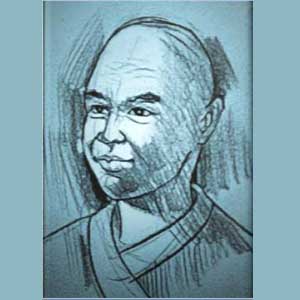
The most important sources regarding Srivijaya as the centre of learning are the detailed writings from the famous Chinese pilgrim by the name of I-Tsing. He stayed in Srivijaya for a total of approximately ten years. Apart from I-Tsing’s writings, there are also writings from other pilgrims from China, India, Arab and Persia.
I-Tsing
I-Tsing (635-713) was one of three famous Chinese pilgrims after Fa-Hsien and Hsuan-Tsang. Fa-Hsuen was the first Chinese monk who travelled to India and stayed there for a period of 15 years, between 399-414 CE. Meanwhile, Hsuang-Tsang stayed in India for 17 years, between 629-645 CE. Since his teenage years, I-Tsing has always dreamt of embarking on a pilgrimage to India. His dream was eventually realized at the age of 37.
I-Tsing’s Expedition to Indonesia
At the age of 37, I-Tsing sailed from China (671 CE) and landed in Fo-Shih, where he stayed for 6 months to learn sabdavidya (Sanskrit grammar) before leaving for Mo-lo-yeu, which is also referred to as Shih-li-Fo-Shih, where he then stayed for 2 months. In early 672 CE, I-Tsing departed to India through Ka-cha (Kedah) and stayed in Nalanda for 10 years.
I-Tsing returned to Mo-lo-yeu in 685 CE/early 686 CE, which, according to his journal, “… has now become (part of) Fo-shih; there are many states (under it)”. This journal agrees with the content of Kedukan Bukit inscription (683 CE), where Sri Dapunta Hyang led the victory parade of Srivijaya’s conquest of the Malay kingdom.
I-Tsing then stayed in Srivijaya for four years. In the year 689 CE, I-Tsing was back home in China for three months, after which he returned again to Fo-Shih and stayed there for 6 years. I-Tsing went back to China in the year of 695 CE.
I-Tsing’s Travel Journal
Overall, I-Tsing stayed in Indonesia for about 10 years. In the three books that he wrote, I-Tsing described at great length his experiences and observations during his stay in Srivijaya and India. The three books are listed here under:
- “Nan-hai-chi-kuei-nai-fa-chu’an”, written in 691-692 CE. This book was translated from Chinese into English as “A Record of the Buddhist Religion as Practiced in India and the Malay Archipelago” by J. Takakusu in 1896.
- “Ta-t’sang si-yu-ku-fa-kao-seng-ch’uan” was also written in 691-692 CE, and was translated by Professor Chavannes from Chinese to French as “Memoire a l’epoque de la grande dynastie Tang sur les religieux eminents qui allerent chercher la Loi dans les pays d’Occident” in 1894.
- Mulasarvastivada-ekasatakarman, was written soon after he returned to China in 700-703 CE.
Significance of I-Tsing’s Journal
Prof. Dr. Slamet Muljana in his book Sriwijaya mentioned that most of the historical accounts in Srivijaya that we encountered were publicized by historical sources from outside of Indonesia, especially from China, as well as authentic inscriptions from the age of Srivijaya, written in the language of Srivijaya, Sanskrit and Tamil. Thus, journals of pilgrims who visited Srivijaya constitute an indispensible source.
I-Tsing, in his book “A Record of the Buddhist Religion as Practised in India and the Malay Archipelago”, wrote a few interesting lines that carry significant importance. Below are a few quotes from the book:
- “In the walled city of Fo-Shih, (lived) Buddhist monks number more than 1,000, whose minds are bent on learning and good practice”.
- “They investigate and study all the subjects that exist just as in Middle Kingdom (Madhya-desa, India); the rules and ceremonies are not at all different”.
- “If a Chinese monk wishes to go to the West in order to hear (lectures) and read (the original) scriptures, he had better stay here one or two years and practice the proper rules and then proceed to Central India“.
 Bahasa
Bahasa
 October 24th, 2010
October 24th, 2010  SUDIMUJA
SUDIMUJA  Posted in
Posted in  Tags:
Tags: